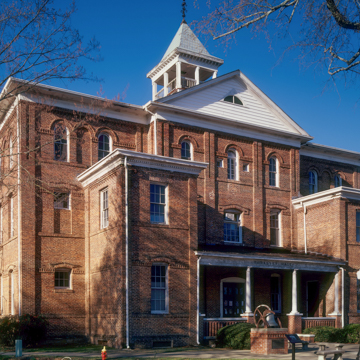You are here
Thrasher Hall
Thrasher Hall was architect Robert R. Taylor’s first brick building for Tuskegee Institute. Students and teachers erected the structure in 1893 using bricks they had made on campus. Originally called Science Hall, the building housed science laboratories and classrooms on the first two floors, with a boy’s dormitory on the third. Like most of Taylor’s dormitories (Rockefeller Hall being a rare exception), Thrasher Hall featured a three-story veranda with terraces on its main facade; above the veranda is a bell tower. Students living in the third-floor dormitory could access the upper veranda for fresh air and use the pavilion roofs as viewing terraces. In 1903, school founder Booker T. Washington renamed the building in honor of Max Bennett Thrasher, his New England-based publicist. Thrasher Hall was renovated in 1983 to house university offices. Only the exterior walls of the historic structure remain, and the bell was also removed at this time.
References
Fluker, Roderick. “Tuskegee Charts a Progressive Course: 1953-1969.” Paper presented at symposium, The Architecture of Historic Black Colleges and Universities: Principles, Legacy, and Preservation. Morgan State University, Baltimore, Maryland, November 2015.
Massey, Dean James Earl. A Bridge Between: A Centennial History of Campus Ministry at Tuskegee University 1888–1988. Tuskegee University, n.d.
Weiss, Ellen B. Robert R. Taylor and Tuskegee: An African American Architect Designs for Booker T. Washington. Montgomery, AL: New South Press, 2012.
Weiss, Ellen B. “Tuskegee: Landscape in Black and White.” Winterthur Portfolio 36, no. 1 (Spring 2001): 19-37.
Writing Credits
If SAH Archipedia has been useful to you, please consider supporting it.
SAH Archipedia tells the story of the United States through its buildings, landscapes, and cities. This freely available resource empowers the public with authoritative knowledge that deepens their understanding and appreciation of the built environment. But the Society of Architectural Historians, which created SAH Archipedia with University of Virginia Press, needs your support to maintain the high-caliber research, writing, photography, cartography, editing, design, and programming that make SAH Archipedia a trusted online resource available to all who value the history of place, heritage tourism, and learning.




















